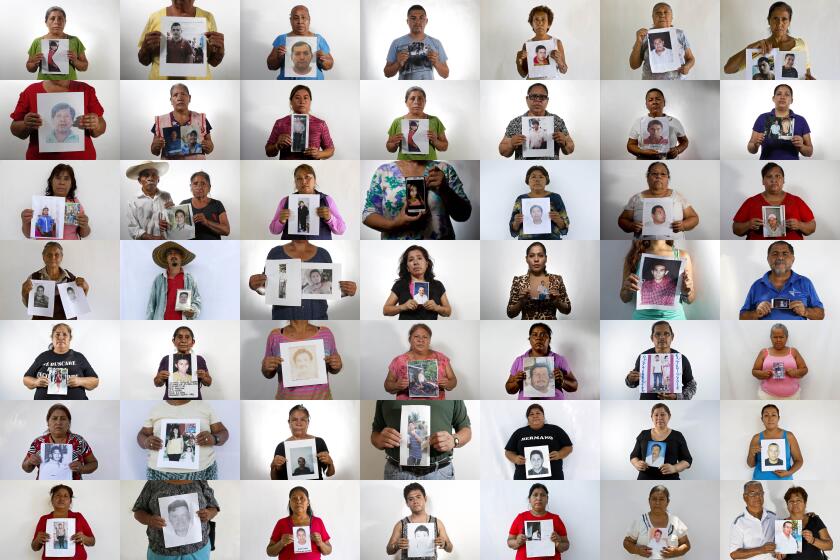
- Share via
Mexico City — Calling herself a “child of 1968,” Mexico’s newly inaugurated President Claudia Sheinbaum issued a formal apology Wednesday for one of the country’s most notorious episodes — the brutal repression and murder of student protesters 56 years ago in the capital’s Tlatelolco district.
“We cannot forget Oct. 2,” said Sheinbaum, who assumed office on Tuesday as the nation’s first female president.
The “Tlatelolco massacre,” during which Mexican security forces opened fire on demonstrators, unfolded amid the global upheaval of the 1960s, notable for antiestablishment, antiwar and civil rights protests. Mexico’s then-authoritarian leaders were keen to present an image of order and stability before the 1968 Summer Olympics, the first held in Latin America.

Sheinbaum, a leftist activist, condemned the government’s 1968 actions in remarks at her inaugural mañanera, or morning news conference, continuing the tradition of media sessions launched by her predecessor and mentor, Andrés Manuel López Obrador.
Seven decades after Mexican women won the right to vote, Claudia Sheinbaum takes office as the country’s first female president,
Her initial mañanera, which featured a video recalling the events of 1968, lasted about an hour and a half — a contrast to the meandering, often-three-hour talkathons presided over by López Obrador, who stepped down Tuesday; under Mexico’s Constitution, presidents can serve only one six-year term.
In her remarks on the anniversary of the 1968 massacre, Sheinbaum — who is also commander in chief of the armed forces — accused then-President Gustavo Díaz Ordaz of being responsible for the actions of soldiers and police who committed “one of the greatest atrocities that Mexico lived through in the second half of the 20th century.”

On the evening of Oct. 2, 1968, forces opened fire on thousands of demonstrators, mostly students, gathered in Tlatelolco’s central square, the Plaza of Three Cultures, named after the country’s Indigenous, European and mestizo formation.
The onslaught culminated weeks of student-led, pro-democracy protests, mirroring anti-Vietnam War protests that were jolting the United States and Europe. “One could hear the steady gunfire and the rattle of machine guns,” Elena Poniatowska, the acclaimed Mexican author, wrote in her 1971 chronicle, “The Night of Tlatelolco.” The plaza, she wrote, “was converted into a living hell.”
Early reports put the death toll at a few dozen, including students, soldiers and police. But human rights activists later said it was likely that more than 300 people, most of them students, were killed.
It happened a quarter of a century ago, shortly after 6 p.m. and just 10 days before the opening of the XIX Olympiad: Soldiers and riot police opened fire on thousands of demonstrators, mostly students, who had gathered in this capital’s historic Tlatelolco district, once an Aztec stronghold.
Tlatelolco was for years a mostly taboo topic here. But, starting in the 1980s, the repression of 1968 was discussed more openly as demands for democratic change shook the dominance of the Institutional Revolutionary Party, or PRI, which ruled Mexico for most of the 20th century. Its candidates had inevitably posted crushing electoral triumphs — Díaz Ordaz was elected in 1964 with almost 90% of the popular vote.
Many here credit continuing outrage about Tlatelolco for helping to spur reforms in Mexico and the weakening of the PRI — and, ultimately, the rise of opposition governments in the 21st century as Mexico moved toward a more democratic path.
“The student movement of 1968 opened the doors for political participation for the young and all of society for a more democratic country,” Sheinbaum said.

Sheinbaum is the standard-bearer of the National Regeneration Movement, known as Morena. The party, founded by López Obrador, who left the PRI decades ago during a reform upheaval, currently dominates Mexican politics. Ironically, many opponents now dub Morena the “new PRI,” saying it has tried to cover up rising violence and “disappearances” and handed over unprecedented power to the military — a critique rejected by Sheinbaum.
Critics say the government of Mexican President Andrés Manuel López Obrador is trying to downplay how people have disappeared in recent years.
In issuing a government apology, Sheinbaum, who was a grade-schooler in Mexico City when the Tlatelolco massacre took place, acknowledged an “obligation” and personal motivation: Her mother, Annie Pardo Cemo, 84, participated in the 1968 protest movement as a professor at Mexico’s National Polytechnic Institute. The institute expelled Pardo for her involvement, Sheinbaum said.
Pardo, a biologist whose family fled Bulgaria during World War II, later became a professor at the Autonomous National University of Mexico — where her daughter, the future president, studied, taught and earned a doctorate in climate science.
Special correspondent Cecilia Sánchez Vidal contributed to this report.
More to Read
Sign up for Essential California
The most important California stories and recommendations in your inbox every morning.
You may occasionally receive promotional content from the Los Angeles Times.















